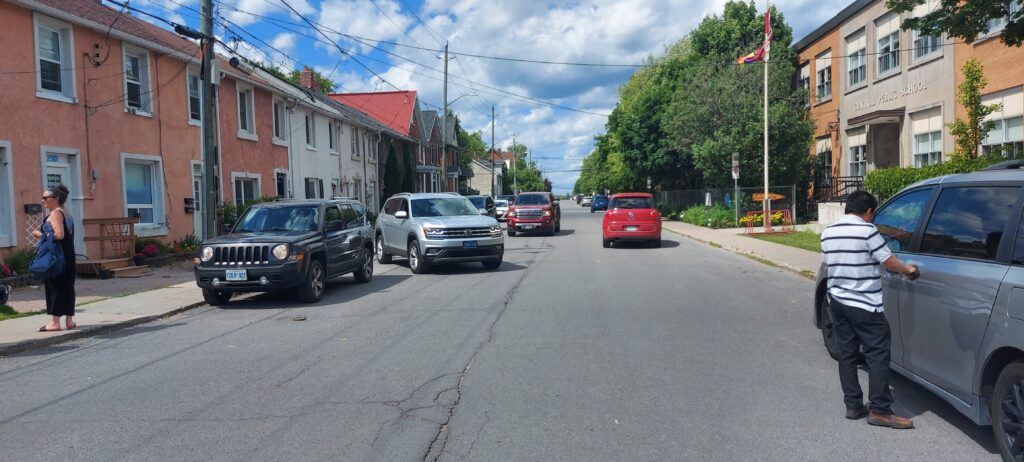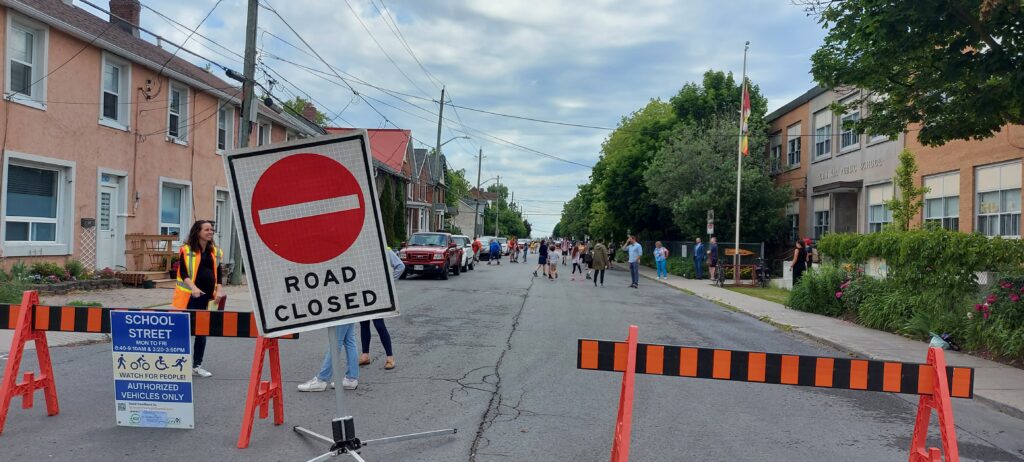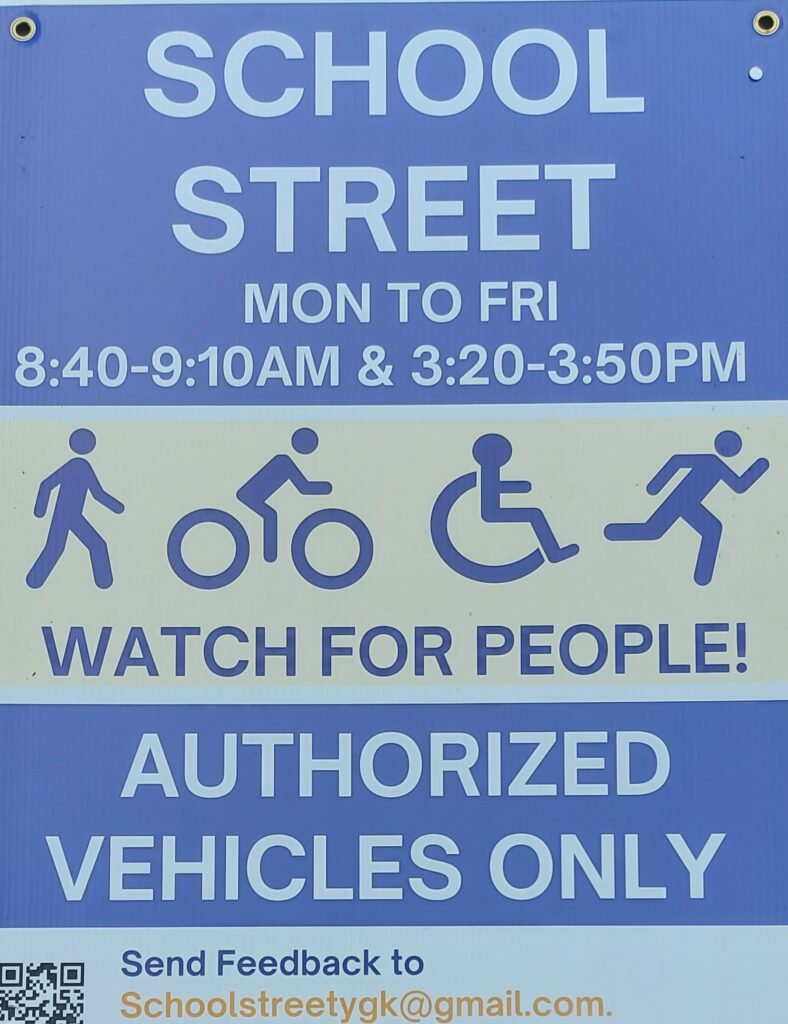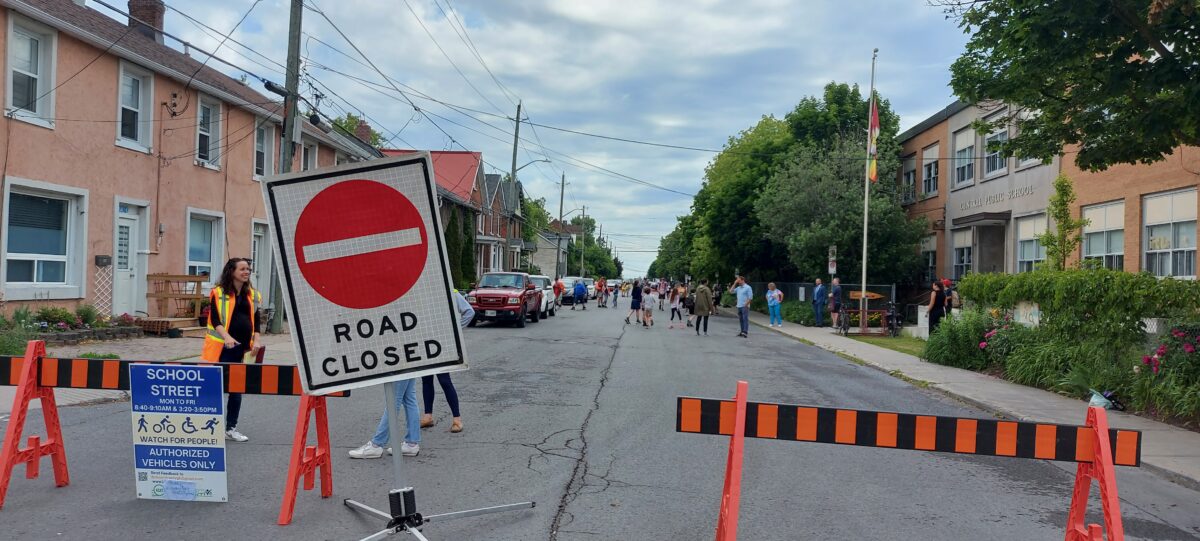Beginning in June 2021, I established a School Street – a street closure program that restricts vehicle traffic and encourages active school travel at the start and end of the school day. With support from the Kingston Coalition for Active Transporation, I managed 50 volunteers to close a street and create a safe space for children more than 100 times since September 2022. This work has been featured in the Kingston Whig-Standard (September 2, 2022) and The Skeleton Press, Issue 11, Fall 2022 (page 30) – featured on this page.
Thirty minutes before the school bell rang, dozens of kids ran into the street screaming at the top of their lungs. “We own the street!” they chanted. Parents and passers-by smiled, casually curious about what was going on, as they strolled along an open road. It was Tuesday morning on Sydenham Street, and it was Central Public School’s first School Street.
In lay terms, School Streets are timed traffic restrictions: a street near a school is closed to vehicles at 30-minute intervals at pick-up and drop-off times. It’s an idea that is long overdue. Before cars, city streets were shared by users of all sorts – horses, trams, and kids alike. Nowadays, cars dominate street use in terms of legal entitlements, funding, and actual allocated space. But people-oriented takeovers are taking shape. From open street festivals to full pedestrianization, as was done on Napier Street in Kingston, there’s a growing demand to reorient streets to the needs of communities.
This is where School Streets come in. Following initiatives from the London (UK) boroughs of Hackney and Camden in 2017, as well as from Winnipeg in 2020, Kingston hosted the second year-long School Street in Canada – and the first in Ontario – at Winston Churchill Public School in 2020. The expansion of the program to Central Public School along Sydenham Street between Ordnance and Colborne is receiving rave reviews.
“Kids really like it, and it’s really fun to run on the street and have no cars”, says Jane, 8 years old, and a Central student. A fun street is indeed part of a larger vision for School Streets. The Kingston Coalition for Active Transportation (KCAT), which led the initiative with Winston Churchill Public School and were instrumental in getting it off the ground at Central, lists improved safety, lower stress, increase in active transportation and physical activity, and social connection between caregivers among the benefits of the projects. There may also be public health benefits associated with the project: clearing school streets of traffic can reduce the potential for long-term chronic illness associated with air pollution and noise.


The importance of seeing streets as public space is clear even to young people. As Stella, age 11, pointed out, “after COVID, we just had to stay in one spot, and this gives us more space.” Indeed, contrary to the City’s early pandemic closures of public spaces, public health professionals across the world encouraged people to meet outside safely as much as possible. School Streets, in this way, may be a small step towards creating a new and more accessible public space, especially for children who otherwise do not have a say in how their streets are used.
School Streets can also be seen as prioritizing the needs of parents who can walk their kids to school, instead of favouring those who need a car to drive to work. Stella, again responds to this critique: “from the car’s perspective, I think it should be fine because it’s only closed for about half an hour, and they can easily go around.” In fact, one of the big surprises of Central’s first School Street was the decrease in overall traffic near Sydenham Street. Residents and visitors to Providence Manor, instead of driving by Central School to get to Queen Street, simply chose a different route, effectively reducing traffic for the parents who did drive. An unintended outcome of the School Street is that it may be making drop-off routes easier for car-dependent families. Nonetheless, ensuring that all school programs do not adversely effect those who require vehicles for economic or mobility reasons is an essential measure to review as the program continues.

Still, one street closure does not necessarily equal a safe passage for children, caregivers, and teachers. For that, we will require a rebalance of the entire street network and begin to favour the needs of those who are absent, specifically public transit-dependent residents, people with disabilities, senior residents, and importantly, children and youth. In fact, the Central Public School Advisory Council sees School Streets as working in tandem with other initiatives that tip the scale back towards people-oriented transportation, such as a biking school bus, or a pedestrianized street network surrounding Skeleton Park. Ultimately, it is up to all of us to rethink who streets are for and how we use them.
The School Street will be back at Central Public School starting in September and will run every school day, rain, shine, or snow, throughout the rest of the year. To do this, the Advisory Council is asking for additional parent or local resident volunteers to set-up and take-down road barricades each day. These volunteer “bearriers” (shoutout to the Central Bears!) might also design other placemaking initiatives, and envision the long-term change that is needed for safer, accessible, and social streets we all want.
Please message [email protected] to ask to be involved!
This blog post was originally published in The Skeleton Press, Issue 11, Fall 2022 (page 30)
